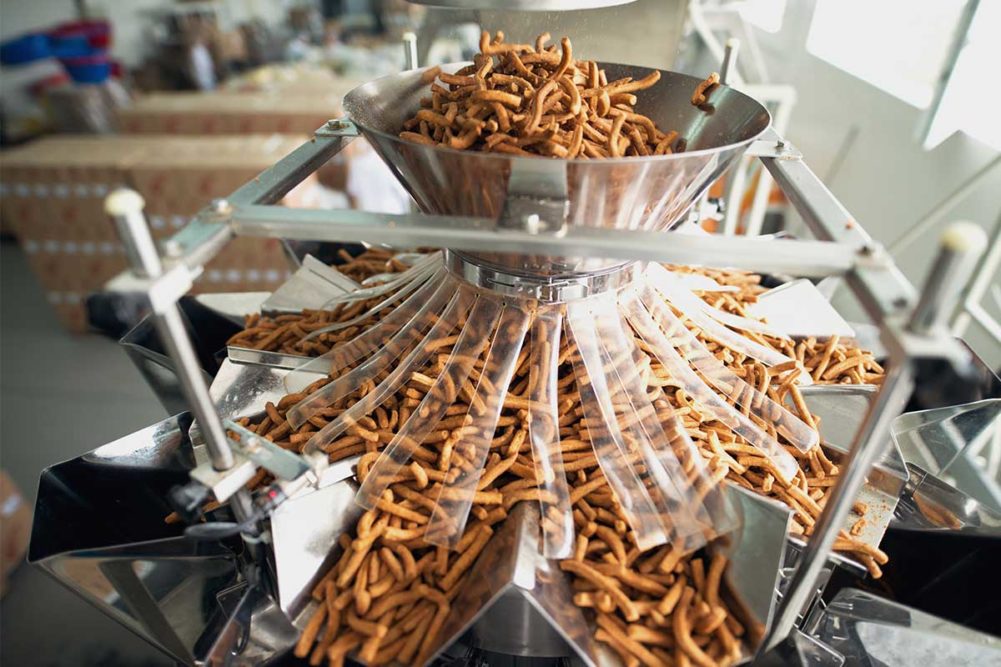For snack makers looking to meet high throughput demands or quickly change between products, a high-speed, efficient line is essential. Advancements in packaging technology are providing manufacturers this needed boost by minimizing changeover and downtime.
TNA Solutions, for example, recently launched the “Perfect Pair,” which combines its VFFS robog 3e with its auto-splice 3. The robag 3e produces a range of products at up to 250 bags a minute, while the auto-splice system automatically joins a new film to an expiring film roll, allowing for uninterrupted packaging.
“Traditional methods required halting production to manually change film rolls, leading to unnecessary downtime,” said Mukul Shukla, vice president, TNA North America.
For an operation running three 7-hour shifts per day at a speed of 140 bags per minute, Shukla noted the new system could produce an additional 3.5 million bags annually and reduce machine downtime by 385 hours.
Christian Romualdi, group marketing communication manager, IMA IlaPak, noted the company upgraded the jaws carriage on its VFFS Vegatronic 6000 to allow increased production speeds on a variety of pack styles.
Joe Curcio, northeast sales manager of BluePrint Automation, observed the company continues to replace pneumatic devices with servo-driven devices to increase the speed of the company’s packaging lines.
“It started with the most obvious motions, and now almost everything is driven by servos,” he said.
Speedier lines can offer a big boost to a snack operation, but they may also open the door to greater inaccuracy and product waste if managed improperly.
“Increasing speeds when packaging snack bags is more difficult than running a rigid container, like a can of soda,” Curcio said. “Many times it takes high-speed cameras and years of experience to get bags to handle at higher speeds.”
For this reason, Dennis Gunnell, president, Formost Fuji, emphasized that some snack makers may actually boost throughput by slowing their lines down.
“We have a number of customers who have gotten more product out the door by slowing down because they have less waste, less problems, less downtime,” he said. “I’m seeing that as just as important, and in some cases, more so than increasing line speed.”
With this in mind, manufacturers must search for the sweet spot between speed and accuracy when packaging their snacks. Almond observed an effective way for producers to enhance both is to dedicate their line to a specific pack size range.
“The snack manufacturer instead should determine whether the need is greater small bag capacity, more production per square foot, or better anticipation of change in bag size mix,” he said.
He added that dialing in the feed control to the weigher and optimizing chute angles and transitions to keep product charge as compact as possible help improve accuracy and reduce product waste at higher speeds.
Optimizing speed and accuracy is no easy feat, Gunnell noted, and requires snack manufacturers to communicate with suppliers on what they plan to run on a packaging line. He said too often a snack maker will try to run a product they didn’t inform the supplier of when the machine was installed, which leads to a host of issues if the product isn’t fit for it.
Each relevant department at the snack facility should be involved in these decisions, he said.
“Everybody should be on the same page so that engineering doesn’t design something or buy something that production says we can’t produce,” he said.
At the same time, Gunnell stressed the importance of building as much flexibility as possible into machines to adjust to future needs.
“Although each project needs to be defined, and tolerances need to be defined, building that flexibility into the line as much as you can is important as well,” he explained. “So that balance is really working with the customer to define what the next two, five or seven years look like.”
Romualdi echoed this, noting the flexibility needs requested by a customer significantly impact the efficiency of the machine. He said IMA-Ilapak’s R&D team has focused on a fast and effective format changeover system across its machines.
“Thanks to these efforts, the most critical operations related to format changes are now completely automatic and toolless,” he said.
This article is an excerpt from the April 2024 issue of Baking & Snack. To read the entire feature on Snack Packaging, click here.






